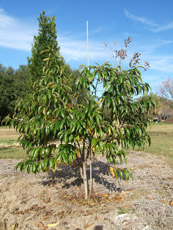Rhamnus caroliniana (Carolina Buckthorn)

*Click on picture for more images of this species.
- USDA Hardiness Zone: 5B - 9B
- Mature Height: 12 to 15 ft
- Mature Spread: 10 to 15 ft
- Growth Rate: Moderate
- Availability: Rarely available
- Drought Tolerance: High
- Salt Tolerance: Unknown
- Light Requirements: Full sun to partial shade.
- Native Origin: Native to Florida.
- Soil Drainage: Needs a well-drained site.
- Foliage: Deciduous tree with showy fall color.
- Flowers: Yellow, not showy flowers in the spring.
- Pests: No insect pests of major concern. The main disease is crown of rust and leaf spot.
Description: Carolina Buckthorn develops an open crown of many slender branches and is usually seen at 12 to 15 feet in height although it is capable of reaching 30 feet in a partially shaded location with support from surrounding trees. The bright green, deciduous leaves change to a gorgeous orange/yellow or red in autumn before dropping. The fairly inconspicuous, early summer flowers are greenish- white and followed by small, showy red fruits which ripen to black in the fall when their flesh becomes sweet and edible. Birds find the fruits irresistible. The thin, smooth bark is gray with dark markings.
Carolina Buckthorn is quite attractive in the landscape and is one of the first fruiting plants to show color. Use this small tree or large shrub in a shrub border to attract birds and for a late summer accent. It can be planted in mass to form a thicket which should provide food and cover for a variety of wildlife. It might also be tried as a street tree where overhead space is restricted by power lines. Carolina Buckthorn should be grown in full sun on well-drained soil, acid or alkaline. It is moderately drought-tolerant.
Gainesville Observations: Trees are vigorous and should be well suited for planting near power lines. Plants are likely to remain well below lines as the plant wants to be a shrub more than a tree. Foliage turns yellow in winter without much leaf drop until new leaves appeared in spring.

